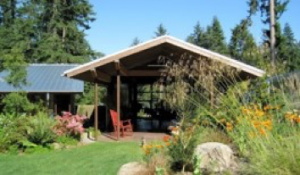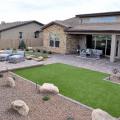Scope
Design a water-efficient landscape that will minimize the need for supplemental water by using the WaterSense® Water Budget Tool. In single-family homes, pools, spas, and other water features shall be treated as turfgrass.
Exemptions:
- Lots with total landscape-able areas equal to or less than 1,000 square feet.
- Multi-family buildings, common-use pools/spas and all areas that are reserved for private use of a particular residence/unit (e.g., areas deeded, identified as limited-use common elements, or otherwise restricted by building management) are excluded from the landscape-able area.
Additional criteria apply to pools/spas in Criterion 4.1.4: Pools/spas.
See the Compliance Tab for links to related codes and standards and voluntary federal energy-efficiency program requirements.
Description
Turfgrass is frequently over-watered by homeowners who do not understand its water requirements. A water-efficient landscape consists of a variety of medium- or low water-using plants in combination with functional turfgrass areas. Limiting turfgrass to areas where it aesthetically highlights the house or where it has a practical function such as in play areas can increase the water efficiency of the yard while still providing benefits to the homeowner. Some communities have prescriptive requirements that limit the coverage of turfgrass as a means to address their local water supply challenges.
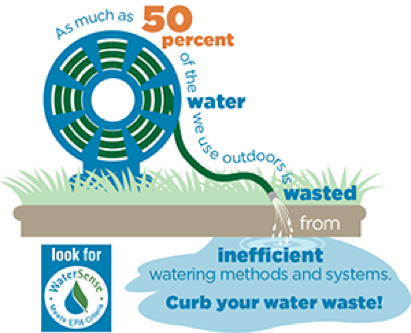
The WaterSense® Water Budget Tool provides the landscape designer flexibility, incorporating regional differences and plant water requirements. The intent is to determine a regionally appropriate amount of water that can be applied to the landscape, then design a landscape that will require no more than this amount. A water budget is a site-specific method of calculating an allowable amount of water to be used by the landscape, then designing the landscape to meet this budget. The budget takes into account plant type, plant water needs, irrigation system design, and applied water that the landscape receives either by irrigation or by precipitation. Water budgets must be associated with a specified amount of time, such as a week, month, or year.
The water budget tool guides the user through the water budget calculation in three parts. First, the tool calculates the amount of water a standard landscape would require and the amount of water the designed landscape is allowed in order to be considered water-efficient. Next, the tool calculates how much water the designed landscape requires based on climate, plant type, and irrigation system design. Lastly, it determines whether the designed landscape meets EPA’s criteria.

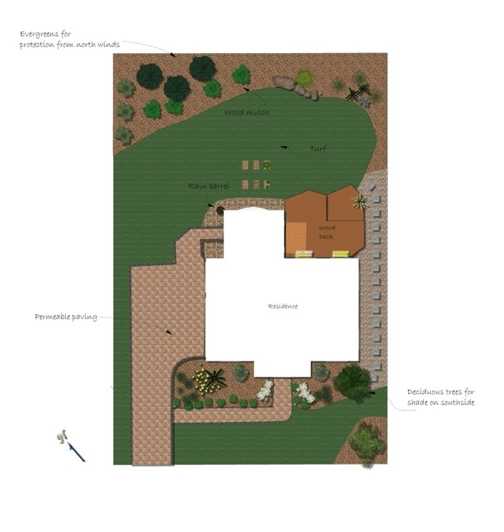
WaterSense chose a well-maintained lawn composed entirely of green turfgrass (i.e. cool season turfgrass using 100% of the reference evapotranspiration) as the baseline, or conventional model, and a 30% reduction in associated water use as the reduction that would result in water efficiency. This does not mean that WaterSense maintains a lawn should be watered with 70% of the water it requires, but that a plant mix should be selected that would use 30% less water than a landscape comprised entirely of turfgrass. The data used to calculate water use, discussed below, are modeled across the entire United States by zip code, resulting in site-specific allotments. Therefore, while every yard of a WaterSense labeled home must achieve the same minimum percentage reduction, the actual requirement, in gallons of water, varies greatly based on what is appropriate for each region. Additionally, the data are conservative in nature in order to result in a landscape capable of withstanding the most challenging months of the year.
In addition to the types of vegetation planted and irrigation equipment installed, the tool requires two climate-based inputs: local reference evapotranspiration (ETO) and rainfall. These inputs are automatically supplied via the online Water Budget Tool and are also available via the Water Budget Data Finder, which is searchable by zip code. The Water Budget Data Finder must be used to generate the information for the Water Budget Tool. The tool also requires the use of a landscape coefficient for each category of vegetation planted. WaterSense has assigned relative species factors to each category within the broad plant types—trees, shrubs, groundcover, and turfgrass—for the builder to use.
The WaterSense Water Budget Tool functions well for its intended purpose of promoting a water-efficient landscape design. However, it should not be used to determine irrigation scheduling amounts, nor for estimating potential water use, as it would likely result in the over-application/estimation of water.
Table 1. The WaterSense Water Budget Tool gives designers region-specific guidance for water-efficient landscaping (courtesy of U.S. EPA WaterSense Program)

The landscape professional should consider the local climate when selecting plants and group plants with similar water needs, a practice known as hydrozoning. For example, drought-tolerant plants such as sages or cacti would not be planted in a bluegrass lawn, but would be separated, since bluegrass has a higher water requirement. Hydrozoning also seeks to take advantage of microclimates. Plants that tolerate more heat and wind might be planted near the street, while more sensitive plants might be planted in shade, under roof overhangs, or in fenced areas. Hydrozoning can also refer to a design practice undertaken to improve irrigation efficiency. The system is designed so that plants with similar watering requirements are watered together and separated from plants with different requirements. For example, one group of plants might need watering for 20 minutes, while another group of plants may need only 10 minutes. Similarly, one group might require year-round watering, while another might require it for only a small portion of the year.
The EPA's WaterSense Water Budget Approach document guides the user through the WaterSense Water Budget Tool and provides examples of the water budget options in different regions of the country. Homes that are built in areas that have prescriptive landscape requirements must still use the Water Budget Tool to meet the specification; however, it is likely that the prescriptive criteria (which typically limit coverage of turfgrass) will result in a landscape that meets the tool. For single-family homes, pools, spas, and other water features must be included in this area and are counted as turfgrass. For multi-family buildings, the landscaped area should not include pools, spas, and water features.
Other Measures for Outdoor Water Efficiency
The above criteria is highly recommended to provide a strong foundation for a water-efficient landscape. There are many additional strategies that can be implemented to go above and beyond the scope of this specification. Although none of the following items in this section is required by the WaterSense® specification, qualified landscape and irrigation professionals should be considering these strategies as they design the landscape. Certain strategies such as site preparation will require coordination between the builder/developer and landscape professionals. A water-efficient landscape begins in the planning stage with all parties involved. Please consider the following additional strategies to minimize outdoor water use and maximize onsite water retention:
Permeable Surfaces

- Install permeable surfaces, rather than impermeable hardscape, where appropriate. Impervious hardscape surfaces such as driveways and sidewalks contribute to stormwater runoff from the site. Stormwater transports pollutants and sediment to nearby water bodies and can lead to erosion downstream. To decrease storm water runoff, permeable hardscape can be used in place of any impervious hardscape materials or—if unnecessary—removed altogether. This will increase infiltration of water, replenishing aquifers and providing a healthier site for landscape plants.
- Where hardscape on the lot is necessary, open pavers or engineered porous materials are a good replacement for impermeable concrete. Permeable pavement options include porous bituminous asphalt, porous concrete, porous paver blocks, and reinforced turf.
- When considering permeable pavements, builders should be mindful of site constraints and maintenance requirements. One potential site constraint is a shallow water table. Stormwater is cleaned as it percolates through the soil, but a shallow water table may intercept storm water from permeable pavements before the water is sufficiently cleaned. Additionally, builders should recognize that like all hardscapes, permeable pavements require maintenance.
Soils
- Preserve or restore proper soil structure, chemistry, and depth prior to installing landscape plants. Soil structure, chemistry, and depth are essential to the survival of landscape plants. In many cases, nutrient-rich topsoil is removed from the site, or soil compaction occurs during construction. Healthy soils support thriving plants and biological communities, as well as provide water storage and infiltration, reducing runoff.
- The landscape professional should conduct a thorough analysis of both the physical and chemical characteristics of the soil. Based on this analysis, the professional should prepare the soil according to locally accepted best management practices. This may include the addition of top soil, other soil amendments, tillage, or other strategies to create the appropriate planting medium for landscape plants. Soil amendments and tillage improve soil’s capacity to support vegetative growth by increasing soil water-retention capacity, improving infiltration, and enhancing soil fertility.
Site Development
- Minimize site clearing during the construction phase and ensure appropriate site requirements, such as soil depth and proper grading, prior to landscape installation. Conventional construction practices disturb the site by clearing existing vegetation and moving earth, resulting in bare, compacted soil. Compacted soil makes it difficult for water to pass through the soil and reach the roots of the plants. Construction practices increase erosion, inhabitability of the site for new vegetation, and the likelihood of stormwater runoff. A site that is minimally disturbed is preferable, because it has decreased landscape water use, healthier soils, and decreased erosion and runoff.
- Builders should make construction crews aware of site preservation and ensure compliance with all local construction codes related to erosion and stormwater control. Consider grading and topsoil installation where appropriate and repair compacted soils prior to landscape installation by tilling or other suitable means.
Valves
- Water flow in irrigation systems is controlled through the use of valves. Valves can be manually or automatically operated and can be used in various irrigation applications to shut off flow completely, reduce flow to a set rate, or regulate water pressure. These functions are accomplished using on/off service valves, control valves, check valves, and pressure-regulating valves. An appropriate valve should be chosen based on the desired valve function. Correct valve sizes should also be chosen to account for pressure loss in the valves. Pressure loss is especially important in automatic valves, which rely on pressure differences to power the system. Builders should refer to manufacturer information on valve models to choose the correct valve.
On/Off Service Valves
- Valves used to control water flow by allowing for completely restricted or completely unrestricted flow are known as on/off service valves. On/off service valves are useful in irrigation systems where only certain zones require watering during a scheduled time period. On/off service valves include gate valves, plug valves, and ball valves, which can fully restrict flow, but they cannot achieve a reduced set flow rate or regulate pressure, so should not be used in these applications. On/off service valves can perform well as master valves to control flow to an entire irrigation system. Master valves are recommended for use in emergency situations where water flow to the system needs to be shut off.
Control Valves
- Control valves are used to regulate flow to a set rate below the maximum incoming flow rate. In a control valve system, valve motion is driven by an electric or hydraulic-powered actuator. Automatic irrigation systems with a controller typically use electrically powered solenoid valves to control water flow. Globe and angle valves are commonly used in control valve systems, because they are able to regulate flow rate, and both can be securely shut off. Control valves should be used for zone-by-zone control.
Check Valves
- Check valves allow flow in only one direction. These valves should be installed to prevent backflow from irrigation water, which can contain toxic chemicals from fertilizers and pesticides, from infiltrating the drinking water supply. Ball, disk lift, piston lift, flapper, foot, and diaphragm valves are all types of check valves.
Pressure-Regulating Valves
- Pressure-regulating valves reduce water pressure at the irrigation system inlet to a desired level. A spring is used to throttle water flow in order to maintain a reduced pressure. Irrigation systems tend to perform best at a water pressure of approximately 30 psi. Some irrigation systems, such as drip irrigation, may perform better at lower pressures. Reducing water pressure will in turn reduce the amount of water used.
Controlling Stormwater
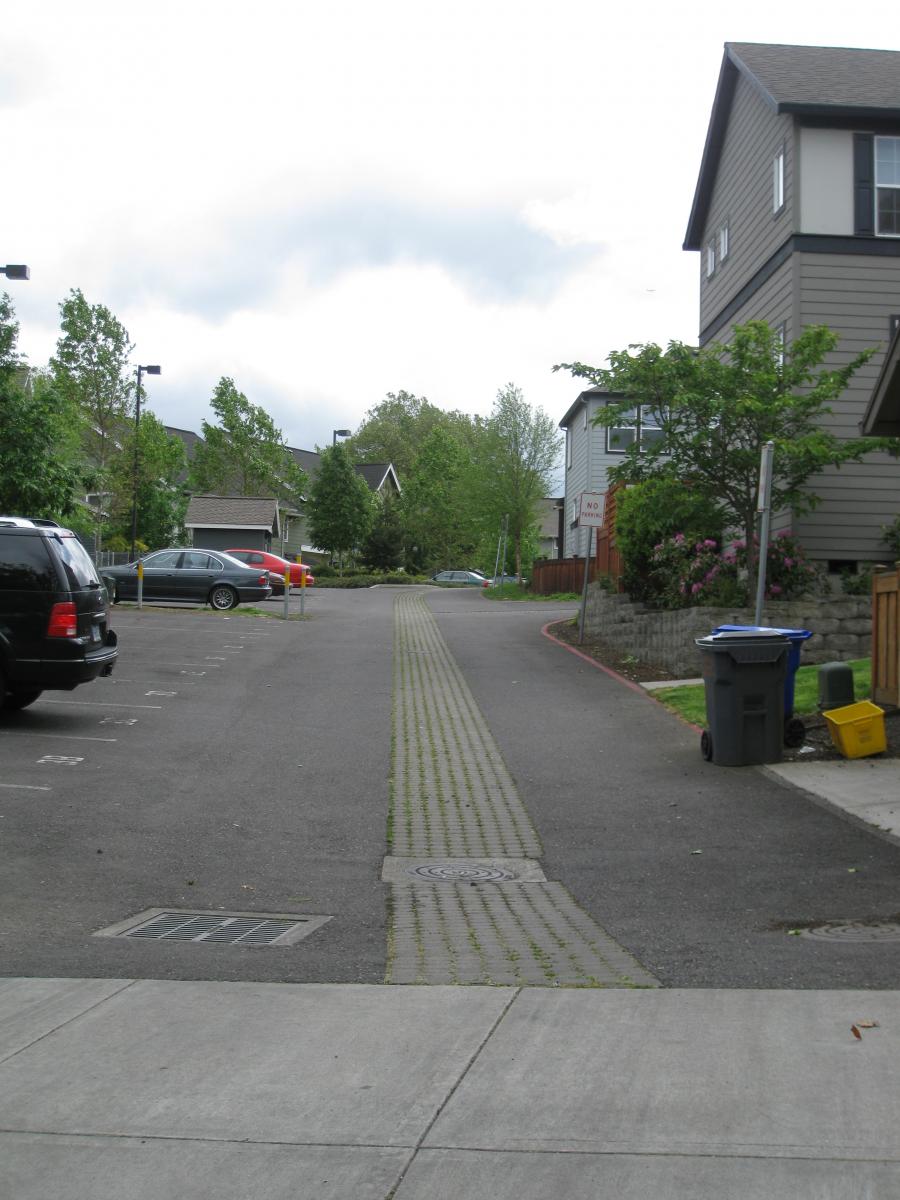
- In addition to permeable surfaces and site development, installing rain gardens, green roofs, vegetated swales, rain barrels, or cisterns will further decrease the amount of stormwater leaving the site and filter out pollutants before they enter the municipal system or are discharged to surface water.
- A rain garden is an excavated, shallow depression vegetated with native plantings that is designed to capture rainwater from roofs, driveways, and sidewalks. Rain gardens allow stormwater to slowly soak into the ground, capturing contaminants and reducing stormwater flows to the sewer system. Rain gardens can absorb runoff up to 40 percent more efficiently than typical lawns. By using a rain garden to capture rainwater, hold it, and then slowly release it into the soil, the peak runoff from storms can be retained or delayed, allowing rainwater to infiltrate into the ground and be cleaned naturally. Rain gardens are sustainable, cost-effective options for reducing the impact of impervious surfaces on stormwater runoff and can be aesthetically pleasing as well.
- Green roofs are vegetated roof covers that include a lightweight, engineered growing media planted with vegetation. They provide stormwater benefits by reducing and delaying stormwater flows from entering the storm sewer system. The number of layers and layer placement of green roofs vary from system to system and green roof type; green roofs should include a single- to multi-ply waterproofing layer, drainage layer, growing media, and plants. Drought-tolerant plants such as Sedums are typical green roof plants. Non-drought tolerant plants can also be used on green roofs with deeper substrate layers (> 6-inch depth, which are considered intensive green roofs). However, such plantings would require irrigation and maintenance and are therefore not favorable for water-efficient homes. Under this specification, green roofs would count as landscaped area, and all appropriate criteria would apply.
- A vegetated swale is a broad, shallow channel with a dense stand of vegetation covering the side slopes and bottom. Swales can be natural or manmade, and are designed to channel stormwater while trapping pollutants (total suspended solids, trace metals, and nutrients), promoting infiltration, and reducing the flow velocity of stormwater runoff. Vegetated swales can serve as part of a stormwater drainage system and can replace curbs, gutters, and storm sewer systems. While swales are generally used as a stand-alone stormwater best management practice, they are most effective when used in conjunction with other best management practices, such as wet ponds, infiltration strips, and wetlands.

Success
In alignment with the HCO's verification protocols and the WACM's technical requirements, the verifier will obtain a copy of the completed Water Budget Tool Report from the builder partner. Using EPA’s Water Budget Data Finder, the verifier will type in the home’s zip code and verify that the correct peak watering month, ETo, and rainfall amounts are used in Parts 1 and 2 of the Water Budget Tool. Next, the verifier will confirm that the areas (square footage) of each category of vegetation installed are approximately the same as those listed in Part 2 of the Water Budget Tool.
To determine the areas (square footage) of each category of vegetation, the verifier should refer to the EPA's WaterSense Water Budget Tool and WaterSense Water Budget Approach.
Climate
Through this specification, builders are encouraged to select native or climate appropriate plantings. Best practice is to choose plantings that are appropriate for the specific features of the site. Even portions of the same site may vary significantly in soil type, exposure to sun, wind, and associated evaporation rates and moisture levels. Smart planting takes into consideration both local and microclimate conditions. A microclimate is a small location that has environmental conditions that are not typical everywhere else in the area. For example, a microclimate might exist near a large rock. As the sun heats the rock, the rock will give off heat. Thus the environment around the rock will be warmer than the area 10 feet from the rock. In addition, the shade produced from a tree might also be considered a microclimate. The temperature under the tree is different from the temperature further from the tree.
The use of drought-tolerant plants, particularly in dry regions, can significantly reduce demand for water, chemicals, and maintenance. In some climates, it is possible to eliminate the need for permanent irrigation through the use of drought-tolerant plants and improved landscape design. Drought-tolerant plants vary by region, and builders should consult local extension offices or other resources to determine appropriate local plants. Slow-growing perennials and shrubs are often good candidates.
Drought-tolerant turfgrass can also help to reduce water use. Like drought-tolerant plants, drought-tolerant turfgrasses vary by region. Turfgrasses are differentiated by warm-season or cool-season turfgrasses. Warm-season turfgrass is typically more drought-tolerant and should be used in warm-weather climates. Some cool-season turfgrasses can also be drought-tolerant, such as fine fescues, and are more appropriate in cold-weather climates.
Training
Compliance
Retrofit
Guidance for the measures described in this guide is applicable to both new and existing homes. Homes with established landscapes may require replacing turf and other plants to meet the criteria.
More
More Info.
Access to some references may require purchase from the publisher. While we continually update our database, links may have changed since posting. Please contact our webmaster if you find broken links.
The following authors and organizations contributed to the content in this Guide.
